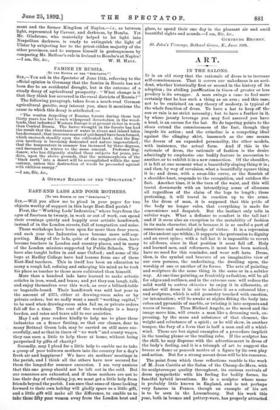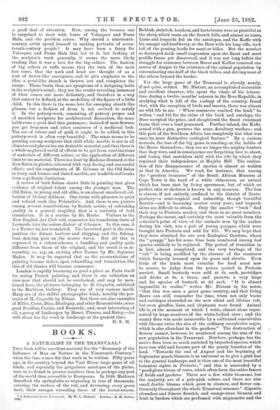ART.
IN THE SALONS.
IT is an old story that the rationale of dress is to increase self-consciousness. That it covers our nakedness is an acci- dent, whether historically first or second in the history of its adoption ; its abiding justification in times of greater or less prudery is its swagger. A man swings a cane to feel more certainly that he has such a thing as an arm ; and this case, not to be explained on any theory of modesty, is typical of the whole function of dress. To have a hat to keep off the sun or rain is no strict necessity ; but to have a feather in it, by whose jaunty leverage you may feel assured you have a head, is an excuse for the bat. So do tapering points to the shoes extend the consciousness of the foot, though they impede its action; and the crinoline is a competing ideal against the clinging skirt, inasmuch as the one means the dream of an expanded personality, the other models, with insistence, the actual form. And if this is the rationale of dress, the rationale of fashion is the desire admiringly to emphasise one bodily feature in succession to another, or to exhibit it in a new connection. Of the shoulder, it is felt at one moment what a beautifully sloping thing it is ; and then, by way of revulsion, what a beautifully square thing it is ; and dress, with a swan-like curve, or the flourish of a shoulder-knot, responds to the recognition, and outdoes the fact. Another time, it is the turn of the waist, and this will travel downwards with an intensifying sense of slimness all regardless of the claim of the legs to length ; these protesting, it will travel in reaction up to the arms. In the dress of man, it is supposed that this pride of the body no longer rules, that everything is made for convenience and despatch. But the instinct only tells in subtler ways. What a defiance to comfort is the tall hat ! and if it seem also an exception to the mutability of fashion in its main character, that is because it is so useful a part of conscience and material pledge of virtue. It is a repression. of the ancient ape within ; it supports the pretension to dignity and an erect spine ; with a tall hat it is impossible to revert to all-fours, since in that position it must fall off. Holy and learned men, and reformers, it must have been noticed, have no need for this reminder, and wear soft hats. Dress, then, is the symbol and bravura of an imaginative view of our own persons, the underlining, the dwelling upon, the worship of one or another of its forms. The arts of painting and sculpture do the same thing in the same or in a subtler way. At one time painting, as freakishly as fashion, will be all for edges and outlines, and in the extreme case will reduce the solid world to ombres chinoises to enjoy it in silhouette, at another will dress it in air to admire it as a coloured blur ; and sculpture, which is solid geometry touched with emotion, (or intoxication), will lie awake at nights fitting the body into cubes and pyramids of marble, or twisting it into serpents and waves of bronze. Thus Michael Angelo, as the mood and the image move him, will create a man like a dreaming rock, ex- pressing, by the mass and substance of that element, the weight and reluctance of a spirit ; or he will show, in another temper, the fury of a form that is half a man and all a whirl- wind. These are but signal examples of a procedure implicit in the tossing plume or the trailing robe. If the sculptor has the skill, he may dispense with the advertisement in dress of the body's feeling, and it is a triumph of art to suggest the breeze or flame or peacock motive of a figure by its own play and action. But for a strong accent dress will be his resource.
The point from which these reflections ramble is the work of M. Jean Carries at the Salon of the Champ-de-Mars, with its sculpturesque quality throughout, its curious revivals of dress sympathetic with his feeling for bodily forms, its fanciful hybrid inventions. He is a sculptor whose name is probably little known in England, and is not perhaps very famous in France, though an example of his art• is to be seen in the Luxembourg. But his work this year, both in bronze and pottery-ware, has properly attracted
a good deal of attention. Now, among the bronzes one is surprised to meet with busts of Velasquez and Frans Hale, and the problem arises : Why should a nineteenth- century artist spend himself in making portraits of seven- teenth-century people P It may have been a fancy for Velasquez and Frans Hale that led to it, but looking at the sculptor's work generally, it seems the more likely reading that it was a love for the big collars. The fashion of big collars or ruffs means that the turn of the neck has come, that the neck and head are thought of as a sort of flower-like emergence, and to give emphasis to the idea, a petal-like sheath is thrown out and completes the image. Those busts, then, are symptoms of a designing habit in the sculptor's mind ; they are the cruder revealing instances of what comes out more delicately, and therefore in a way that cannot be defined, in the modelling of the figure of a little child. In this there is the same love for sweeping sheath like plumes, but a fashion of dress is not revived to satisfy it. In the pottery-work, consisting of pottery proper and of moulded sculpture for architectural decoration, the same habit runs a good deal into grotesque; instead of man-flowers, you get frog-men and other creatures of a mediwval look. The use of colour and of gold, it ought to be added, in this pottery-work is often very beautiful. The sense seems to be growing among sculptors that chill white marble is not in all climates and places the one desirable material, and that there is a whole neglected world of effects to be got from combinations of materials of different colour, or the application of different tints to one material. There is a bust by Madame Besnard at the New Salon in plaster, coloured with very daring and successful effect ; and the experiments of M. Gerome at the Old Salon in ivory and bronze and tinted marble, are laudable outbreaks from a pedantic limitation.
A review of both Salons shows little in painting that gives evidence of original talent among the younger men. The Old Salon, in young and old alike, is an almost unrelieved col- lection of blatant dullness. One turns with pleasure to quiet and refined work like Pointelin's. And there is one picture among several contributions by Scotch artists of refreshing quality in a general stupidity that is a curiosity of bold translation. It is a marine by Mr. Roche. Visitors to the New English Art Club will remember his translation there of Leonardo into the colour-dialect of Glasgow. In this case, it is a Turner he has translated. The borrowed part is the com- position, the distant harbour and shipping, and the fishing- boat dancing past on the nearer waves. But all this is expressed in a colour-scheme, a handling and quality quite different from those of the original, and the result is as in- teresting as, say, an etching after Turner by Mr. Seymour Haden. It may be expected that as the accumulations of painting become richer, open rehandling and translation like this of old themes will become commoner.
London is rapidly becoming as good a place as Paris itself for seeing French painting, and there is one collection on view now that should not be overlooked, and may be men- tioned here, the pictures belonging to M. Coquelin, exhibited in the Barbizon Gallery. They are of very various merit. Many are of the skilful photographic kind; notably the por- traits of M. Coquelin by Friant. But there are also examples of Millet, Corot, Diaz, Daubigny, and other Romanticists; some good Boudins, Cazins, and Besnards ; and, most interesting of all, a group of landscapes by Monet, Pissaro, and Sisley,—for with them lies the word in landscape at the present time.
D. S. M.



































 Previous page
Previous page